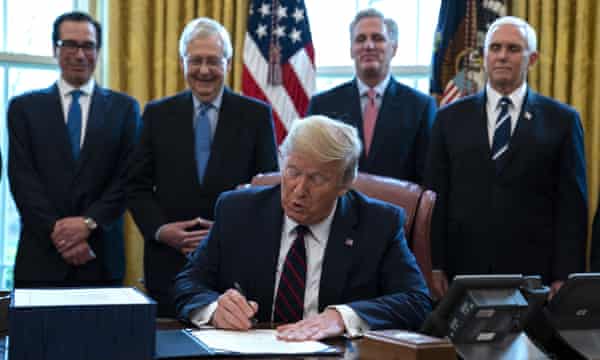Coronavirus has destroyed the myth of the deficit
コロナウイルスは赤字の神話を破壊しました|アメリカ経済|保護者
https://amp.theguardian.com/commentisfree/2020/apr/17/coronavirus-deficit-american-economy?__twitter_impression=true
コロナウイルスは赤字の神話を破壊しました
「財政赤字が制約であるという信念に麻痺して、私たちは自分たちの手段を下回って生きてきた世代のために、赤字の神話に買い入っています。」キャプションを表示
Yeva NersisyanとL Randall Wray
いいえ、連邦政府の支出は「支払われる」必要はありません。危機は、私たちの社会に備えることは経済的な問題ではないことを示しています
2020年4月17日(金)13.31 BST
ほんの1か月前には、2兆ドルの景気刺激策は考えられなかったでしょう。憤慨している赤字の叱責は、それをどのように支払うつもりかを尋ね、孫に借金を負わせて国を破産させたことについて不平を言ったでしょう。バーニー・サンダースは、グリーンニューディールやメディケアフォーオールの支払い方法を説明するために、後ろ向きに曲がりました。これらのプログラムはもはや高価ではないようです。突然、政府は現金の「ヘリコプタードロップ」を計画しています。世界的な金融危機の最中にオバマ氏の刺激を容赦なく攻撃したラリー・カドローは、現在の刺激を「米国史上最大のメインストリート支援プログラム」として宣伝しています。
ウォール街の巨人でさえコロナウイルス危機の真のコストを知らない
誰も私たちがこの刺激にどのように支払うつもりなのかを真剣に尋ねているわけではありません-彼らはそうすべきではありません。連邦政府の支出を「支払う」必要があるという神話を爆発させるには、世界的な大流行が必要でした。
Covid-19の危機は、すでに明らかであったはずのことを明確に示しています。食料、消毒用ワイプ、トイレットペーパー、医療用品など、社会のプロビジョニングは、財務上の問題ではありません。十分なマスク、換気装置、または食糧を生産できない場合、財政は役に立ちません。実際の出力を生成する社会の能力は、それ自体をプロビジョニングする能力を制限するものです。そして、これはまさにウイルスが脅かしていることであり、労働者が家に留まり、サプライチェーンが崩壊し、企業がドアを閉ざします。
現代の貨幣理論家が長い間説明してきたように、財政面では、主権政府はいつでもその通貨で売り物を買う余裕があります。使うときに銀行口座に入金するだけなので、お金を使い果たすことはできません。これは処方箋ではなく、実際に何が起こっているのかを説明するものです。米国では、議会が予算を通過させ、財務省は、その財政代理人である連邦準備制度と協力して、必要な支払いを行います。これは、危機の有無にかかわらず、ビジネスサイクルの濃密を経て発生します。米国政府がより多くの人工呼吸器またはマスクを購入したい場合、財政が妨げになることはありません。
この危機が過ぎると、財政赤字は逆戻りし、進歩的な政策の前に障害物を配置しようとします
しかし、企業が24時間365日稼働しているにもかかわらず、換気装置とマスクが販売されていない場合はどうなりますか?より多くのお金は問題を解決しないかもしれませんが、政府はまだ果たすべき役割を持っています。第二次世界大戦中、米国は戦争のニーズを満たすための生産能力を転用することにより、すぐに「民主主義の武器庫」になりました。勤勉な計画を通じて、「[l] ipstickケースが爆弾ケースになり、ビール缶が手榴弾になり、自動拳銃に機械が追加され、ガスマスク部品に掃除機が追加されました」。 「Liberty Shipsの生産時間を365日から92、62、そして最終的には1日に」短縮することができました。臨時の病院を建設し、医療機器やその他の危機を克服するために必要なものを十分に確保するために、もう一度リソースを動員することができます。
財政が制約であるという信念に麻痺し、赤字の神話に身を投じます。長期にわたる緩慢で失業中の回復により、投資が阻害され、生産能力と労働生産性が損なわれました。良い時でさえ、私たちの経済は何百万もの失業者または不完全雇用を残しており、かなりの量の生産能力をアイドル状態にしています(流行以前は、私たちの工場は生産能力の4分の3しか稼働していませんでした)。私たちは公的医療、教育、インフラへの投資を過小評価し、社会支援プログラムに極端な制限を課しました。これを書いている時点で、行政は依然として70万人のアメリカ人をフードスタンププログラムから解雇し、5年間で約42億ドルを節約する計画を通過することを計画しています。ジョン・メイナード・ケインズが大恐慌で適切に述べたように、私たちは「たくさんの貧困の中で貧困」に住んでいます。
コロナウイルスはどのようにして世界の金融システムを崩壊させたか|アダム・トゥーズ
この危機が過ぎると、財政赤字は再び復活し、進歩的な政策の前に障害物を配置しようとします。メディケアフォーオール、ジョブズフォーオール、カレッジフォーオール、または気候変動を止めることはできないと言われます。中心主義者たちは、私たちを「通常の」、つまり、多くの人々を取り残した経済に戻そうとします。
私たちが抵抗することは不可欠です。進歩主義者がする必要があるもの推進は、グリーンニューディールを通じて別の種類の経済を創出することです。そのためには、神話と実際の制約を区別し、主権政府にとって「技術的に実現可能なことは財政的に可能である」ことを理解する必要があります。グリーンニューディールの実施は、資金ではなく、実際のリソースとテクノロジーに関するものです。
最初のニューディールも、過度の政府支出に関する懸念に悩まされていました。第二次世界大戦はその障害を取り除き、並外れた経済動員と数十年の繁栄を解き放ちました。コロナウイルスの危機が大恐慌ほど破壊的ではないことを願っていますが、破壊すべきことが1つあれば、それは赤字の神話です。
Yeva Nersisyanはフランクリンおよびマーシャル大学の経済学の准教授です
Lランドールレイ、モダンマネー理論の著者:主権通貨システムのマクロ経済入門。なぜミンスキーが重要なのか:マーベリックエコノミストの仕事の紹介。と現代のお金を理解する:完全雇用と価格安定の鍵は、レビー経済研究所の上級研究員であり、バードカレッジの経済学教授です。
Facebookでシェア
Twitterで共有
メールで共有
LinkedInで共有
Pinterestでシェア
WhatsAppで共有する
メッセンジャーで共有
 Show caption
Show caption
Yeva Nersisyan and L Randall Wray
No, federal government spending doesn’t have to be ‘paid for’. The crisis shows providing for our society is not a financial issue
Fri 17 Apr 2020 13.31 BST
Only a month ago, a stimulus bill of $2tn would have been unthinkable. Indignant deficit scolds would have asked how one planned to pay for it, and complained about burdening our grandchildren with debt and bankrupting our country. Bernie Sanders bent over backwards to explain how he was going to pay for a Green New Deal or Medicare for All. These programs don’t seem as expensive any more. Suddenly the government is planning “helicopter drops” of cash. Larry Kudlow, who relentlessly attacked the Obama stimulus during the global financial crisis, is touting the current stimulus as “the single largest Main Street assistance program in the history of the United States”.
Nobody is seriously asking how we are going to pay for this stimulus – and they shouldn’t. It took a global pandemic to explode the myth that federal government spending has to be “paid for”.
The Covid-19 crisis has clearly demonstrated what should have been obvious already: provisioning society – whether with food, disinfecting wipes, toilet paper or medical supplies – is not a financial issue. If we can’t produce enough masks, ventilators or food, finance will not help. Society’s capacity to produce real output is what limits its ability to provision itself. And this is precisely what the virus threatens, as workers stay home, supply chains break down and businesses shut their doors.
On the financial side, a sovereign government can always afford to buy what is for sale in its currency, as Modern Money Theorists have long explained. It cannot run out of money because it simply credits bank accounts when it spends. This is not a prescription, but merely a description of what actually happens. In the United States, Congress passes the budget, while the Treasury, in cooperation with its fiscal agent, the Federal Reserve, makes the necessary payments. This happens through the thick and thin of the business cycle, crisis or not. If the US government wants to buy more ventilators or masks, finance cannot be an impediment.
But what happens when ventilators and masks are not available for sale even as companies are operating 24/7? More money may not solve the problem, but the government still has a role to play. During the second world war, the US quickly became “the arsenal of democracy” by repurposing its productive capacity to meet the needs of the war. Through diligent planning “[l]ipstick cases became bomb cases, beer cans went to hand grenades, adding machines to automatic pistols, and vacuum cleaners to gas mask parts”. We were able to cut “production time for Liberty Ships down from 365 days to 92, 62, and, finally, to one day”. We can mobilize our resources once again to build temporary hospitals, and to ensure a sufficient supply of medical equipment and whatever else is necessary to overcome the crisis.
Buying into the deficit myth, for generations we have been living below our means – paralyzed by the belief that finance is the constraint. Prolonged periods of slack and jobless recoveries have disincentivized investment and hurt our productive capacity and labor productivity. Even in good times our economy leaves millions unemployed or underemployed and a significant amount of our capacity idle (before the epidemic, our factories were only operating at three-quarters of capacity). We have underinvested in public healthcare, education and infrastructure and imposed extreme limitations on social assistance programs. As of this writing, the administration still plans to go through with its plan to kick 700,000 Americans off the food stamps program to save a measly $4.2bn over five years. We have been living in “poverty in the midst of plenty”, as John Maynard Keynes aptly noted in the Great Depression.
Once this crisis passes, the deficit scolds will be back at it again, trying to put roadblocks in front of progressive policies. We will be told we can’t afford Medicare for All, Jobs for All, College for All or halting climate change. The centrists will try to get us back to “normal” – ie an economy that leaves so many behind.
It is imperative that we resist. What progressives need to push for is creating a different kind of economy through a Green New Deal. To do so, we need to distinguish between the myths and real constraints, understanding “that what is technically feasible is financially possible” for a sovereign government. Affording the Green New Deal is about real resources and technology, not about finance.
The original New Deal was also dogged by concerns about excessive government spending. The second world war eliminated that obstacle, unleashing extraordinary economic mobilization and decades of prosperity. Hopefully the coronavirus crisis will not be as destructive as the Great Depression, but if there is one thing it should destroy, it’s the myth of the deficit.
- Yeva Nersisyan is associate professor of economics at Franklin and Marshall College
- L Randall Wray, author of Modern Money Theory: A Primer on Macroeconomics for Sovereign Monetary Systems; Why Minsky Matters: An Introduction to the Work of a Maverick Economist; and Understanding Modern Money: The Key to Full Employment and Price Stability, is senior scholar at the Levy Economics Institute and professor of economics at Bard College



0 Comments:
コメントを投稿
<< Home